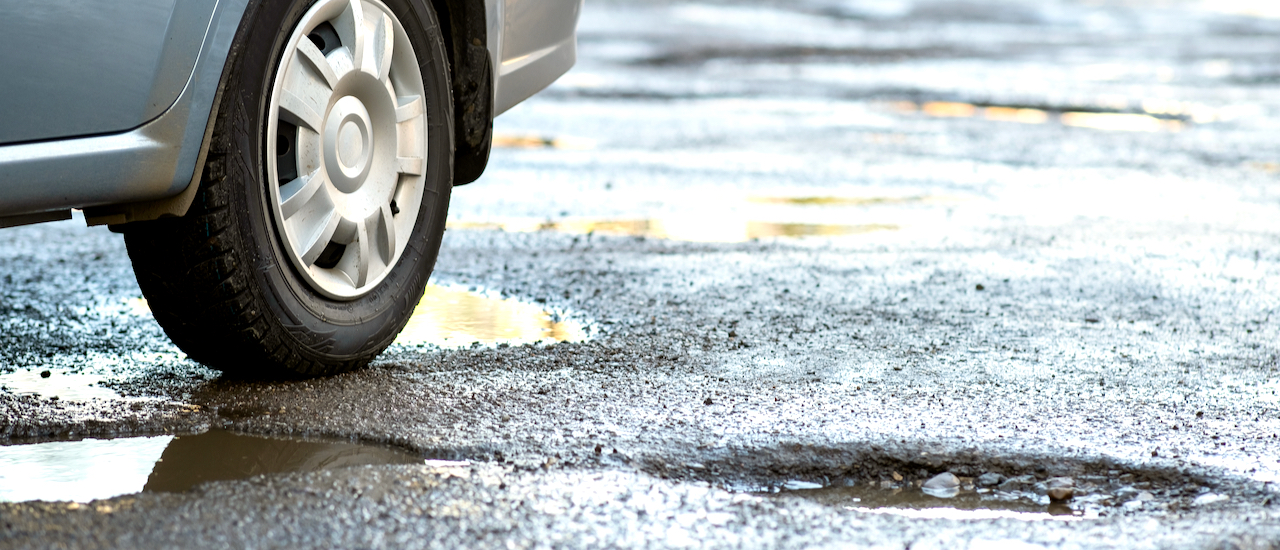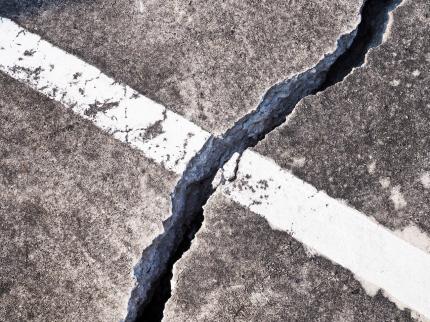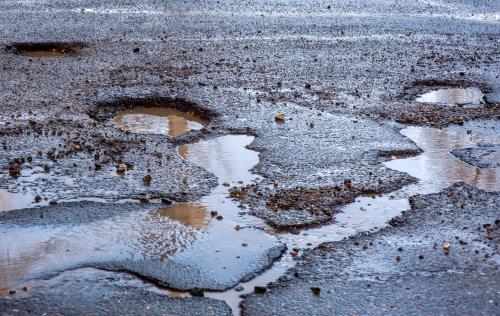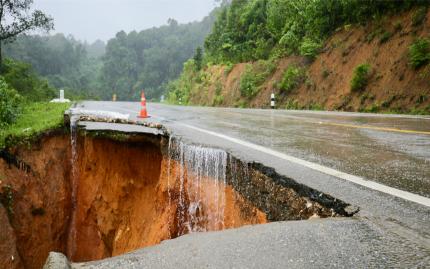
New Zealand’s terrible roads
Why are New Zealand’s highways in such a state of disrepair?
New Zealand’s roads have taken a hammering this summer following heavy rain from successive cyclones. But even before the devastating floods, slips and washouts, the country’s roads were struggling to hold themselves together.

Signs of a maintenance issue years in the making were already beginning to show after 2022 delivered the wettest ever winter in Aotearoa. And the issue was identified by the AA long before widespread deterioration became noticeable. But, despite the AA’s call for better road maintenance ahead of the 2020 general election, pothole commentary has become something of a national pastime. Internet memes and social media groups turned into outlets for frustration about our cratered roads, while the media have chased the situation from the back half of 2022 into the new year. Many AA Members tell us the roads are the worst they’ve ever seen.
The problems culminated in what was billed as Waka Kotahi’s largest ever road renewal programme. The summer of roadworks for 2022/2023 aimed to reseal or rebuild 2,400 lane-kilometres of the state highway, over 10% of the national network between Cape Rēinga and Bluff.
It was a welcome initiative, but many stakeholders say the roads should never have reached such a poor state in the first place. Questions were also asked over how much of the planned summer of roadworks would be completed following the hammering to the North Island by the damaging cyclones Hale and Gabrielle.
Waka Kotahi’s maintenance and operations national manager Neil Walker says the programme was on track at the end of December with contractors finishing 35% of the scheduled works, however the situation in the northern regions could lead to funding and resources being reprioritised, possible delays or cancelled works.
“The damage to the state highway network caused by those weather events may have an impact on our ability to reach 100% of our planned renewals.”
If emergency works exceed available funding in the transport budget, Walker says, money could be reallocated from other road maintenance projects or other National Land Transport Programme activities.
What’s going on?
Waka Kotahi says potholes most commonly form in older pavements when a crack opens and lets water into the road surface, eventually ponding. The hydraulic pressure of vehicles driving over the top forces water deeper into the cracks, loosening parts of the road around the affected area, which eventually break away.

The impact on road users varies from an annoyance to a serious safety threat. Potholes can cause damage to tyres and rims, suspension, wheel alignment and windscreens if loose bits of road break away. Vehicles, particularly motorcycles and cyclists, risk losing control if they hit a pothole, and people swerving or braking to avoid them can also create a dangerous situation. But road maintenance goes beyond just potholes in terms of road safety. The quality of the road surface is about providing good grip and traction to reduce the risk of a vehicle losing control and skidding and also provides better stopping ability.
In October last year it was reported that a pothole on State Highway 29 through the Kaimāī Ranges in the Bay of Plenty punctured the tyres of up to 30 vehicles in the space of a few hours resulting in a queue of stricken vehicles on the side of the road.
Crash investigators are also looking into the causes of a fatal accident on SH29 the same month, where the family of the driver who died believe a pothole was a factor in a vehicle crossing the centreline and crashing headfirst into an on-coming car. The crash left the other driver with serious injuries.
Nick Leggett is the chief executive of Ia Ara Aotearoa Transporting New Zealand, which represents the road freight industry. He says damage to vehicles and lost time from potholes is as big a burden on truck drivers as it is on the any road user. The problem is nationwide.
“The cost from damage and accelerated wear caused by roads where maintenance has fallen behind is significant. Also, it costs when drivers have to sit in traffic slowed by roadworks.”
How did we get here?
Stacy Goldsworthy is the technical manager at Civil Contractors NZ, an industry body that represents many of the firms that construct the country’s roads. He says potholes are an inevitability, but the rain accelerates the deterioration of roads that are already in a poor state.
Nick and Stacy point to the flatlining of Government spending on maintenance in the mid-2010s as having set the wheels in motion for our deteriorating roads. Subsequent budgets, they say, have resulted in Waka Kotahi and road contractors fighting losing battles of catch-up in the years since.
“It started with the National Party’s prioritisation of Roads of National Significance. We were supportive of those projects, but you shouldn’t be robbing Peter to pay Paul,” Nick says.
New Zealand had fallen into a cycle of reactive work to patch its damaged roads using short-term fixes that often have to be repeated, and this system is more expensive in the long run than scheduled preventative maintenance and upgrades.

“The current model lends to cheaper fixes and more maintenance,” Stacy Goldsworthy says.
Waka Kotahi did its best given its limited pool of funding, say both men. Stacy says it has become common for bread-and-butter maintenance to be the poor cousin of new infrastructure projects. “There’s no ribbon cutting for maintenance; it doesn’t get in the newspaper. Capital projects are good – they improve journey times and access – but you’ve got to look after what you already have.”
Neil Walker from Waka Kotahi says the volume of state highway renewal work has indeed been impacted by funding stagnation in the mid-2010s, but other issues are also at play. “The flatlining of funding is not the sole cause for condition issues across the network. Over the past decade a number of factors have contributed, including increasing traffic volumes and climate change.”
As funding plateaued, Stacy Goldsworthy says, the then National-led Government allowed heavier 50MAX trucks (up to 53 tonnes) to operate on the roads – the previous limit was 44 tonnes – which put more stress on the roads and hastened deterioration, a claim also made on Twitter by Minister of Transport Michael Wood.
Nick Leggett disagrees, saying axle configurations spread the weight and payload of a 50MAX truck, causing no more damage than any other truck.
He adds that the trucking industry more than pays its way though road user charges, which in some cases run into tens of thousands of dollars to keep a single vehicle on the road each year. However, this money is not making it back into the roads.
So, where to now?
While unavailable to provide comment for this article, Michael Wood, in previous discussions with the AA, has said the Government was committed to improving roads, pointing to the extra $500 million allocated to repairs across the latest three-year funding cycle.
On social media he has pointed out that expenditure on State Highway maintenance has increased significantly under Labour following ‘historic underinvestment’ by National. But Nick Leggett says blaming the previous Government doesn’t wash. “It’s true the budget issues didn’t start under this Government but they’ve since had half a decade [in power].”
The maintenance budget needs to keep up with inflation, he says. The upkeep costs for roads is up to 50% more per kilometre than a decade ago. Waka Kotahi has also experienced high staff turnover over the last several years and has lost a lot of valuable technical expertise.
Nick suggests now is an appropriate time for a review of the agency’s processes, including its use of materials, approach to work and how maintenance is carried out.
Civil Contractors’ Stacy Goldsworthy says better lasting treatments on high-traffic roads would go a long way to shoring up the network. Chipseal is the material of choice for most of New Zealand’s sealed roads; it is relatively cheap and suitable for most roads. More expensive structural asphalt offers more durability and smoothness, which is better suited to high-use network areas.
Government budget constraints aside, Waka Kotahi has got on with planning and designing more resilient roads as climate change and extreme weather is becoming more prolific.
Neil says higher standards of weather mitigation are being built into new roads and retrofitted to existing ones. “We anticipate seeing a lot more weather events creating network disruption. Our readiness and response to these events has always been ‘business as usual’ for Waka Kotahi – but it is a growing stress on our capacity and funding.
“The increasing frequency and intensity of significant weather events mean we must think differently about how we deal with these risks in the land transport system. We are increasingly building climate change adaptation into our infrastructure planning.”
Where does the AA stand?
Road maintenance has been on the AA’s radar for a long time. It topped the 2020 Election Calls list of matters needing urgent consideration. Three years on, the situation needs more attention than ever.
Ahead of the last three-year funding cycle, the AA estimated that our roads needed an additional $300 million per annum to catch up on the backlog. The $500m in total announced by the Government was a marked improvement, but $400m short of returning the roads to what the AA believes is needed.
A recent survey of our 10,000-person AA Member Panel put fixing road surfaces at top of the list of potential transport improvements they supported; 85% want more done than the Government's current work.
The AA’s road safety spokesperson Dylan Thomsen says putting off maintenance work has the effect of creating a bigger and more expensive future problem for the Government.
The cost to individuals is also mounting. “Repair shops in places such as Northland and Taranaki have reported big increases of people coming in for tyre and rim repairs, or suspension and alignment fixes – all costs that households wouldn’t have faced if the potholes weren’t there.”
The road network is one of New Zealand’s biggest assets – roads are like a ‘shop window’ for regions. It is hard for people to feel good about their area and how they are being served by authorities when they’re driving on neglected roads.
Motorists pay more than $4 billion a year in fuel tax and Road User Charges, Dylan says, and safe, well-maintained roads is the least we should expect.
Read more from this AA Directions issue while you're here:
Reported by Matthew Tso for our Autumn 2023 issue
